Social-Emotional Needs and Support
| Site: | Colorado Education Learning Management System |
| Course: | 2e (Open Access) Supporting Twice Exceptional Learners |
| Book: | Social-Emotional Needs and Support |
| Printed by: | Guest user |
| Date: | Sunday, 14 December 2025, 9:25 PM |
Description
Table of contents
- Universal Needs
- A Nurturing Environment
- Look Beyond the Behavior
- CASEL: 5 Core Competencies
- Self-Awareness & 2e
- Social Awareness & 2e
- Self-Management & Executive Function
- Relationship Skills
- Decision-Making
- Underachievement
- Strategies: Big Picture Support 1
- Strategies: Big Picture Support 2
- Strategies: Big Picture Ideas, conclusion
- 2 FREE SEL Courses - Optional
- Optional Resources for Supporting Mental Health of 2e Learners
Universal Needs
Note: Please also keep in mind that in a 15 hour course, you are getting the big ideas, not the details--one of the many reasons to remember to know the specialists in your building/district and to collaborate!
Many districts in Colorado already have an initiative around social-emotional learning (SEL). Does your district? Is there purchased or district/school created curriculum in place? If you don't know, check with someone in your building or in your central administration.
After basic physical needs are met, it is hard to underestimate the importance of higher order needs, such as feeling cared for and belonging. A sense of belonging forms the foundation of self-esteem, self-efficacy, achievement, and of higher-level thinking. It is always good to remember psychologist Abraham Maslow's hierarchy of human needs (see below).
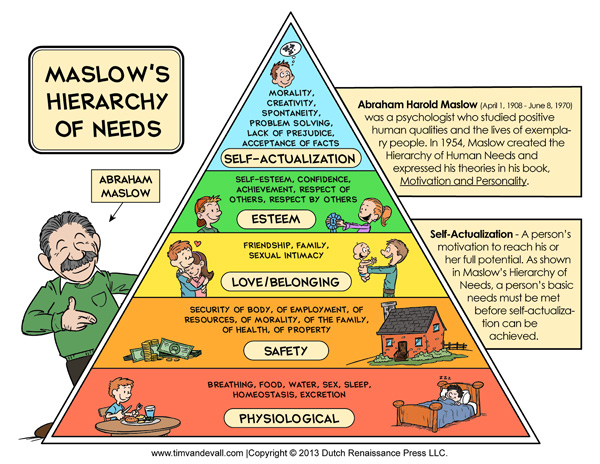
Twice-exceptional children are often at risk for increased social emotional difficulties because their exceptional talents and learning problems grate against each other. They experience a confusing blend of strengths and weaknesses that can leave them feeling frustrated, depressed, anxious, sometimes angry, and with low self-esteem --not knowing whether they are "smart" or "stupid."
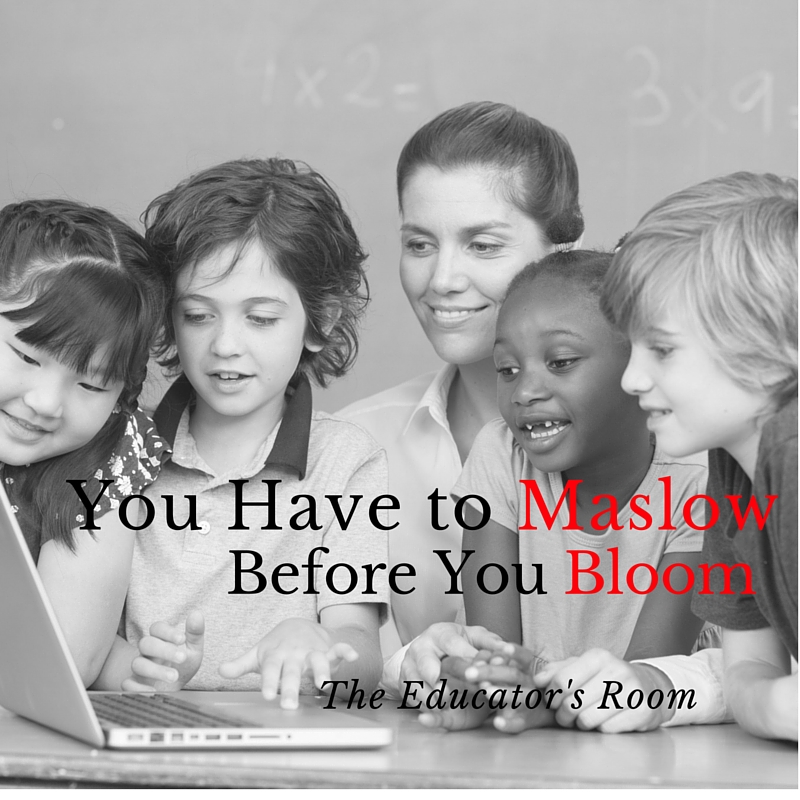
Picture Credit -Article: "Gotta 'Maslow' Before You 'Bloom"'"
These internal conflicts inhibit talent development and trigger fight or flight responses. ADHD and autism spectrum disorder are also comorbid with weak executive function (EF) or EF delays, but often 2e students don't come to the attention of educators until their behaviors become extreme, and then the focus is on getting rid of the poor behaviors instead of preventing it by examining the underlying causes of it.
Knowing this, it is very important that we recognize that while 2e learners need universal SEL instruction, they need more--differentiated lessons and/or tier 2 and sometimes tier 3 support. This section will introduce the five social emotional (SE) core competencies that all learners need and some additional concerns and supports for 2e students. As you go through this lesson, keep your student in mind. What SE guidance and supports do they need? Please locate appropriate areas on your student data form in which you to note the SE need(s) and the supports for your student.
As their teacher, administrator, counselor, etc., you need to begin to get to know the child in order to meet their basic needs (as identified by Maslow): safety, social, self-esteem, and self-actualization. Extrapolating from Maslow for 2e learners:
- Help them feel safe - because they live constantly in fear of being seen as stupid.
- Help them socially - because they have trouble fitting in with their peers.
- Focus on building up their self-esteem - because too often we focus on what they can't do rather than honoring their strengths.
- Reinforce their self-actualization - because they often know what they want to do and become frustrated when they are unable to meet their own already high expectations.
A Nurturing Environment
Establishing a positive, nurturing environment is an essential first step. The importance of your school climate cannot be overstated. This is a graphic from CDE's school climate webpage enumerating some of the benefits, such as increased student engagement and decreased behavioral challenges, that come from a positive climate:
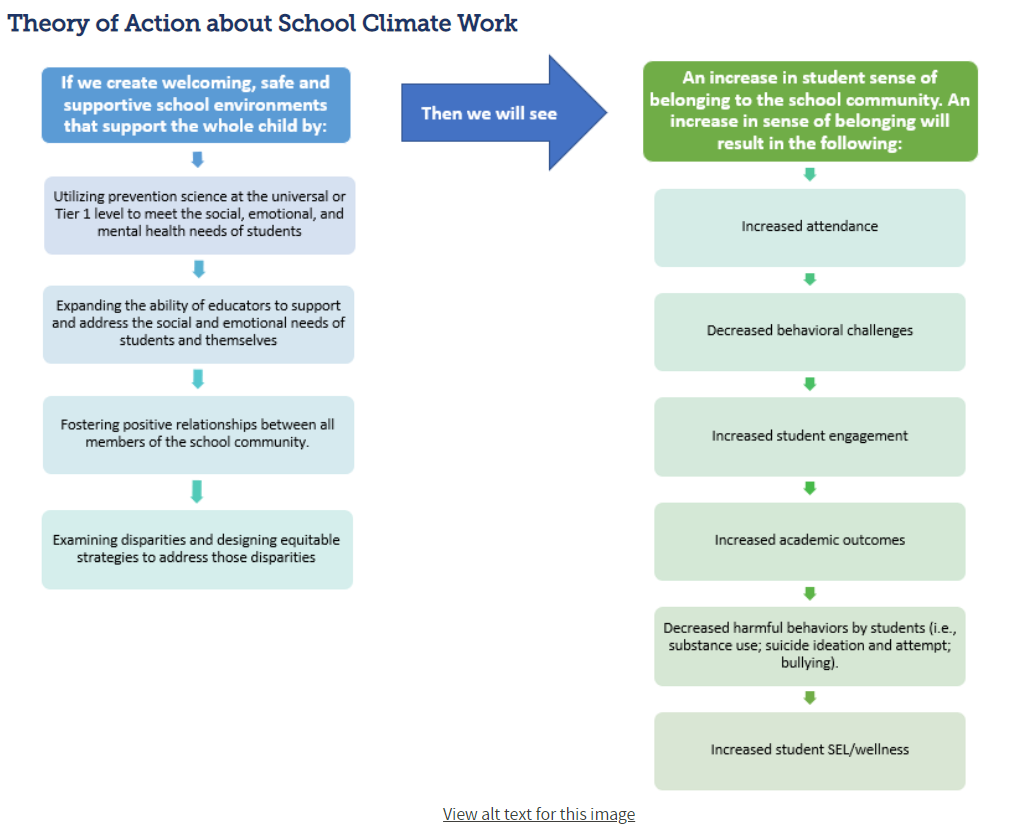
Active link for alt text for the image
Brene Brown in Dare to Lead" (2018) tells teachers that
we can't always ask our students to take off the armor at home, or even on their way to school, because their emotional and physical safety may require self-protection. But what we can do, and what we are ethically called to do, is create a space in our schools and classrooms where all students can walk in and, for that day or hour, take off the crushing weight of their armor, hang it on a rack, and open their heart to truly being seen....And what I know from the research is that we should never underestimate the benefit to a child of having a place to belong--even one--where they can take off their armor. it can and often does change the trajectory of their life (emphasis added, 13).
You can start this process by listening to the child, talking with them and their parents, and looking for ways to be an encouraging adult in their life. Watch this quick video (5 minutes, 18 seconds) to help frame your thinking around the "why" we should create a nurturing school environment
The ideal for a 2e student is to have an environment that will recognize and build on their strengths to promote success. The environment, as well as the perceptions of educators who work with the student, will have an impact.
Optional resources to review now and/or bookmark for future reference:
Learning Environment: Setting the Stage for Academic Success, Chapter 4, in Leading and Managing a Differentiated Classroom by Tomlinson & Imbeau. (PDF)
School Climate Improvement Strategies - CDELook Beyond the Behavior
Amygdala
Did you know that the brain feels before it thinks? The amygdala (think 'fight or flight' part of the brain) receives stimuli 40 milliseconds before the cortex (the thinking part of the brain) (LeDoux, 1996).
What this means is that stress impedes learning. It is imperative that educators connect with their students and work to create a learning environment for them that positively impacts their learning.
In REDUCING STRESS: HELPING TWICE-EXCEPTIONAL STUDENTS UNDERSTAND THEIR EXCEPTIONALITIES , Patricia Schuler looks specifically at our 2e learners and stress and ways to help 2e children deal with them. Practical suggestions like stress boxes and what's on your plate provide strategies for students to learn about their stress. Books that support students and the stressors they may feel are also suggested in her article.
Here is a quote from her article:
Twice-exceptional (2e) children live a daily struggle trying to understand themselves and the educational world they face. We often hear their frustration, anger, stress, anxiety, and denial. We often see their depressive symptoms, fear of failure, dependency, and social distress. They struggle to maintain a precarious balance between dealing with the expectations of being gifted and desperately trying to cope with learning, emotional, and social difficulties.
In a poll where kids were asked what caused them the most stress, this is what came up: grades, school, homework (36%); family (32%); friends, peers, gossip, teasing/bullying (21%) (Kidshealth, 2016).
Twice-exceptional students report that they experience
anger, frustration, and resentment because of recognizing the discrepancy
between their potential and their social and academic problems, which can
further influence relations with peers. They
know they are capable of high-level thinking and insight, but they cannot
express or demonstrate these adequately due to their disabilities. Some common social &
emotional stressors 2e students MAY face include:
Being aware of this emotional toll is critical in helping 2e students. Equally important is recognizing the emotional issues they’re apt to encounter at each stage of school. In the book To Be Gifted and Learning Disabled, Drs. Baum and Owen provide a framework for these issues. At the elementary level, fear of embarrassment and looking stupid in front of peers is paramount. Middle and high school students may experience feeling overwhelmed, isolated, and alienated along with the fear of failure or success, and fear that their disability will be exposed. At all levels, these children can experience a lowered sense of self-efficacy, negative perception of self-worth, frustration, procrastination, underachievement, anger, anxiety, and depression.
Besides stress, 2e learners have some social-emotional risk factors (asynchronous development, uneven abilities, overexcitabilities) that have the potential to also create low self-esteem. (Some indicators of low self-esteem are: anger and disruptive behaviors, self-criticism, crying, withdrawal, apathy, daydreaming or lost in fantasy, denying problems, and depression).
THINK: Does any of this pertain to your student?
What can you do?
To simply a complex endeavor, remember that 2e learners need 1) relationships and 2) relevance throughout their school day. There is a great deal of research that shows that relationships are crucial for all learners but are especially important for learners who are academically or affectively at risk. Relevance means that instruction is at the student's "Zone of Proximal Development," and they understand why they are learning whatever it is.
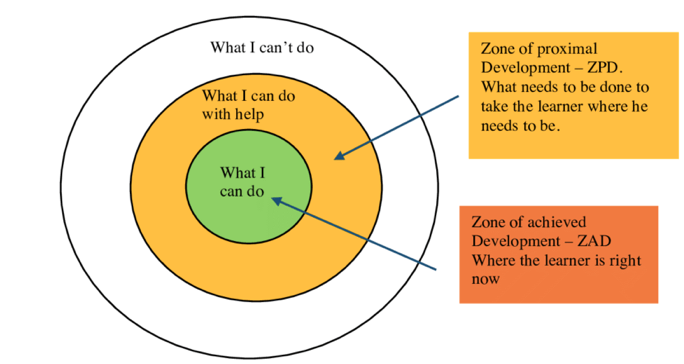
For more information see ZPD on NEA -- optional
Relevance is a problem for many gifted students because they continue to be asked to do things they mastered years ago. Relevance can also be a problem when high-level conceptual understanding--higher order thinking--clashes with a disability, such as dyslexia, and the student is continually given low level content in order to master decoding skills.
Another essential element in meeting the educational needs of students who are 2e is to provide instruction that emphasizes students’ strengths and interests while remediating their learning deficits - dual differentiate, but focus on strengths first. The self-concept scores of learning disabled (LD) students who were also receiving gifted services were significantly higher than those receiving services for their learning disability only.
Here are some readings that may be of interest: (Optional - FYI - bookmark for later use)
- “Gifted Kids at Risk: Who’s Listening?” (Dr. Pat Schuler).
- “The Problem of Procrastination” (T. Quek)
- “Addressing the Social and Emotional Needs of Twice-Exceptional Students” (Emily Williams King)
- “The Affective Side: Emotional Issues of Twice-Exceptional Students” (Jean Strop and David Goldman)
- The Social/Emotional Needs of Twice-Exceptional: What do we know? Maureen Niehart
- Overexcitability and the Gifted (Sharon Lind)
- Guiding Students with High Abilities: Social and Emotional Considerations (Indiana Department of Education)
CASEL: 5 Core Competencies
Just like all students, 2e learners need universal instruction in the 5 core social emotional competencies identified by the Collaborative for Academic, Social, and Emotional Learning (CASEL): self-awareness, self-management, social awareness, relationship skills, and responsible decision-making.
This includes: The ability to establish and maintain healthy and rewarding relationships with diverse individuals and groups. The ability to communicate clearly, listen well, cooperate with others, resist inappropriate social pressure, negotiate conflict constructively, and seek and offer help when needed.
- Communication
- Social engagement
- Relationship building
- Teamwork (Credit: CASEL)
The 5 Competencies Explained
1) SELF-AWARENESS is the the ability to accurately recognize one’s own emotions, thoughts, and values and how they influence behavior. The ability to accurately assess one’s strengths and limitations, with a well-grounded sense of confidence, optimism, and a “growth mindset.” Support for self-awareness is helping students
- Identify emotions
- Have an accurate self-perception
- Recognize strengths
- Build self-confidence
- Build self-efficacy
2) SOCIAL AWARENESS is the ability to take the perspective of and empathize with others, including those from diverse backgrounds and cultures. The ability to understand social and ethical norms for behavior and to recognize family, school, and community resources and supports. It includes:
- Perspective-taking
- Empathy
- Appreciating diversity
- Respect for others
3) Self-management: The ability to regulate one’s emotions, thoughts, and behaviors effectively in different situations. This includes:
- Impulse control
- Stress management
- Self-discipline
- Self-motivation
- Goal setting
- Organizational skills
One glance at the list of behavioral traits that are developed in this competency will help you see how a gifted student with ADHD will need more than universal support to develop self-management skills!
Self-motivation can also be diminished when a student blames herself for failure because a learning disability has not been identified.
Stress is an increasing problem for all children. Research shows it is a common problem for gifted students and can be an even greater problem for a gifted student who is also struggling with a disability.
4) Relationship skills: The ability to establish and maintain healthy and rewarding relationships with diverse individuals and groups. This includes communicating clearly, listening actively, cooperating, resisting inappropriate social pressure, negotiating conflict constructively, and seeking and offering help when needed.
Equally as problematic is finding teachers, coaches, and other adults who understand the unique combination of extreme strengths and limitations typical of gifted and 2e students.
These are learners who need your understanding and skillful support!
5) Responsible decision-making: The ability to make constructive and respectful choices about personal behavior and social interactions based on consideration of ethical standards, safety concerns, social norms, the realistic evaluation of consequences of various actions, and the well-being of self and others. This includes:
- Identifying problems
- Analyzing situations
- Solving problems
- Evaluating
- Reflecting
- Ethical responsibility
Credit for all information below: CASEL
2e Students
Gifted children, often feel they don't fit in. Finding true peers who share their curiosity, their deep interests, their breadth of knowledge, and their quirky sense of humor can be a challenge. Twice exceptional students have an even greater challenge; they occupy a unique and little-understood niche. They are not fully part of the gifted world nor of the special education world nor the world of neurotypical students. Belonging to no group can produce in these children an enormous emotional distress which prevents them from performing at their expected levels.Self-Awareness & 2e
Understanding Their Giftedness
All gifted children need to understand their giftedness to understand themselves. For 2e students, however, much of school (and sometimes daily life) shapes them to be acutely aware only of their weaknesses and struggles. They are in urgent need of understanding their giftedness. A gifted education specialist is best positioned to help them understand what giftedness is and what it is not, but you can facilitate this connection and get the conversation started. You can discuss intellectual and personality characteristics as well as above average abilities in their different areas with them. One of the most important steps you can take is to affirm that giftedness doesn't mean you don't struggle, and it is about being different--not better or worse than others.
This article, "Talking With Your Child About Giftedness" by NAGC will help you frame the conversation and learn how to listen. It is written for parents and caregivers, yet any adult in a gifted child's life can help them develop much needed self-awareness. Take a few moments to look it over and perhaps bookmark it.
Students are ready to examine their areas of weakness once they begin to recognize and accept their giftedness and all its manifestations, from intense feelings to creative ideas. It’s not unusual for 2e students to express denial of this side of themselves. Helping them to fully understand their disabilities or deficits leads them to see that these are only a part of who they are. Children may need time to accept this unwanted reality in their lives, to come to see that they will have to deal with it on many levels: academically, socially, and emotionally. In time, although sometimes reluctantly, their focus on “Why me?” turns to an acknowledgment that they need to learn compensatory strategies. Students can learn about this other side of themselves -- their other exceptionality -- in a variety of ways. On the Internet, one source of information is www.ldonline. Resources online are constantly changing so simply searching for resources is often helpful.
For some student-friendly books and other resources to help them understand their disability see this shared document in our Google folder (optional).
Sometimes it can be a life-altering experience for students to speak with older people who are twice exceptional to find out how they navigated their school, home, and social worlds. Many successful 2e adults enjoy sharing their experiences -- the pain they felt, how they overcame hurdles, how they set goals, who helped their progress, and how knowledge and perseverance paid off.
Once students begin their journey in understanding themselves, their anxiety tends to lessen. To help them organize the information they gather, You can have the students create two binders, one to keep at school and one for home. In them are sections for information from these categories:
- Self-Advocacy
- Strengths/Interests
- Current Data (learning style, report cards, test results, etc.)
- IEP or 504 Plan
- Strategies
- Middle School, High School, College Preparation
- Resources/Articles
Organizing information about themselves helps keep students on track for learning additional strategies. It’s also a way to continue gathering more data as they learn to become independent learners and to deal with their emotional issues.
The Result?
Helping twice-exceptional students to discover that they are complex individuals with unique needs will be empowering for most students. They are, as one 8-year old girl said, “kaleidoscopic!” Self-identification is a powerful way to begin the therapeutic process in counseling or to start providing services in a school setting. Focusing initially on developing a student’s abilities, strengths, and interests lays the groundwork for building a trusting relationship, essential to introducing compensatory strategies, accommodations, and/or modifications. Doing something different may evoke intense feelings. Students will, however, be more receptive to taking risks and learning helping strategies once they recognize, understand, and accept their intellectual and emotional exceptionalities.
It is our responsibility to help twice-exceptional children discover their strengths and limitations and to reframe the gifted/other exceptionality experience. By doing so, they will learn that their differences are assets to be acknowledged, accepted, and perhaps even celebrated.
Some Other Self-Awareness Practices
1. Reflective journaling
2. Mindfulness activities
3. Strengthen emotional vocabulary - incorporate a feelings poster into the classroom with examples of many types of emotions.
Credit: Patricia A. Schuler. Some of the information here first appeared in the January, 2007, issue of 2e: Twice-Exceptional Newsletter [2eNews] and was reprinted, with permission, in the Spring, 2007 issue of Gems of AGATE, the newsletter of the New York Association for Gifted and Talented Education. MCGT published the article in its January/March, 2008, issue of Outlook.
Self-Advocacy
Not only do our students need adults to advocate for them, they also need to learn the skills to advocate for themselves--this is not a skill that just comes naturally. They need to become experts about themselves so they can share with others what helps them to be successful. Explaining how the educational system works by using a flow chart also helps students see that advocacy for appropriate and sufficient services can begin with them and their parents. A whole issue of the 2e Twice-Exceptional Newsletter is devoted to this topic which includes a vast amount of resources for parents, students, and educators (optional). Once again, this website will prove to be an excellent resource for you.
Optional:
- Reprint from the 2e Newsletter by Mark Bade: Advocating for Twice Exceptional Children
- From the University of Oklahoma's College of Education: ME! Lessons for Teaching Self-Awareness & Self-Advocacy
- From Understood.org: 6 Tips for Helping Your High-Schooler Learn to Self-Advocate
- From the Center for Parent Information and Resources: Best Practices in Self-Advocacy Skill Building
- From SMART Kids With LD: Self-Advocacy: Strategies for All Ages
Of course, there are many more sites and resources out there... what we have here are just a few resources to get you started.
Other References
Baum, S. & Owen, S. (2004). To Be Gifted & Learning Disabled: Strategies for Helping Bright Students with LD, AHD, and More. Mansfield Center, CT: Creative Learning Press.
Bobrick, A. (May/June 1994) “The Tornado Inside.” The Networker, pp. 56-57.
Peterson, Jean Sunde. (1993). Talk With Teens About Self and Stress: 50 Guided Discussions for School and Counseling Groups. Minneapolis: Free Spirit Publishing.
Social Awareness & 2e
Intensities around Fairness, Justice, Spirituality, and Death
For some gifted and 2e learners, intense sensitivity to the needs of others and an intense desire for fairness and social justice can make them aware far before they have the emotional majority to deal with these issues. Philosophical issues that are still abstract, such as God and death, can also have an intense effect on gifted children. This is another way that understanding common traits of giftedness can help them develop a balanced sense of self.
For some 2e students, especially gifted students with autism, a weakness in this competency, e.g., perspective taking, is part of their disability, and they will need much more intensive support. Check with your specialists in SpEd to find more targeted strategies for these students.
Social Awareness Strategies
1. Practice becoming aware of situations around you. Practice by doing the following exercise (as a group or individually)
- Name five different things you can see around the room
- What are most of my peers doing right now and what am I doing? (sitting, reading, lining up, etc)
- Hold a clothing, book, or canned food drive for a local shelter or food bank
- Visit a local assisted living facility as a class
3. Listening Circles - This is a good way to practice active listening. Break the class into small groups and give them a few prepared questions. Each student answers a question and if a student interrupts, remind them that everyone will get a turn.
4. Read books about diversity. Make sure to spend time during and after exploring the ways characters and settings are unique.
5. Team games that require collaboration.
- Have small groups work together to complete a jigsaw puzzle
- Have small groups work on an escape box activity
6. New friends bingo - create a bingo card with getting to know you statements (i.e. I have a pet). This activity allows for verbal or nonverbal communication.
Self-Management & Executive Function
To remind ourselves, self-management is the ability to regulate one’s emotions, thoughts, and behaviors effectively in different situations. This includes managing stress, controlling impulses, motivating oneself, and setting and working toward goals (Credit: CASEL).
One glance at the list of behavioral traits that are developed in this competency will help you see how a gifted students with ADHD or autism will need more than universal support to develop self-management skills!
Executive Function (EF) Skills
Often, when we think of problems with executive functioning, we think of disorganization; however, organization is only one of these important skills.
Here is a list of abilities covered under the umbrella term of executive functioning:
Emotional Control: The ability to manage emotions in order to achieve goals, complete tasks, or control and direct behavior. A young child with this skill is able to recover from a disappointment in a short time. A teenager is able to manage the anxiety of a game or test and still perform.
Flexibility: The ability to revise plans in the face of obstacles, setbacks, new information or mistakes. It relates to an adaptability to changing conditions. A young child can adjust to a change in plans without major distress. A high school student can accept an alternative such as a different job when the first choice is not available.
Goal-directed persistence: The capacity to have a goal, follow through to the completion of the goal, and not be put off by or distracted by competing interests. A first grader can complete a job in order to get to recess. A teenager can earn and save money over time to buy something of importance.
Metacognition: The ability to stand back and take a birds-eye view of oneself in a situation. It is an ability to observe how you problem solve. It also includes self-monitoring and self-evaluative skills (e.g., asking yourself, “How am I doing? or How did I do?”). A young child can change behavior is response to feedback from an adult. A teenager can monitor and critique her performance and improve it by observing others who are more skilled.
Organization: The ability to create and maintain systems to keep track of information or materials. A young child can, with a reminder, put toys in a designated place. An adolescent can organize and locate sports equipment.
Planning/Prioritization: The ability to create a roadmap to reach a goal or to complete a task. It also involves being able to make decisions about what’s important to focus on and what’s not important. A young child, with coaching, can think of options to settle a peer conflict. A teenager can formulate a plan to get a job.
Response Inhibition: The capacity to think before you act – this ability to resist the urge to say or do something allows us the time to evaluate a situation and how our behavior might impact it. In the young child, waiting for a short period without being disruptive is an example of response inhibition while in the adolescent it would be demonstrated by accepting a referee’s call without an argument.
Stress Tolerance: The ability to thrive in stressful situations and to cope with uncertainty, change, and performance demands. We generally reserve our discussion of this skill to adults, since it seems more relevant with this population. We find it helps people understand the kind of work environment they do best in.
Sustained Attention: The capacity to maintain attention to a situation or task in spite of distractibility, fatigue, or boredom. Completing a 5-minute chore with occasional supervision is an example of sustained attention in the younger child. The teenager is able to attend to homework, with short breaks, for one to two hours.
Task Initiation: The ability to begin projects without undue procrastination, in an efficient or timely fashion. A young child is able to start a chore or assignment right after instructions are given. A high school student does not wait until the last minute to begin a project.
Time Management: The capacity to estimate how much time one has, how to allocate it, and how to stay within time limits and deadlines. It also involves a sense that time is important. A young child can complete a short job within a time limit set by an adult. A high school student can establish a schedule to meet task deadlines.
Working Memory: The ability to hold information in memory while performing complex tasks. It incorporates the ability to draw on past learning or experience to apply to the situation at hand or to project into the future. A young child, for example can hold in mind and follow 1-2 step directions while the middle school child can remember the expectations of multiple teachers.
Credit: Adapted by Krista Klabo (CDE School Psychology and Special Education Evaluation Specialist) from Smart But Scattered: The Revolutionary ‘‘Executive Skills’’ Approach to Helping Kids Reach Their Potential, by P. Dawson and R. Guare. Guilford Press.
The National Association for Gifted Children has provided information about Gifted Learners and Executive Function including: factors that may impede a gifted child’s executive functioning, signs that kids are struggling with executive function skills, and strategies to support high-ability learners with executive functioning deficits. Take a few minutes to open and skim the article.CDE does not endorse any person or program. We are sharing some resources that have been shared with us that educators have found useful. Check with your district resources to see if trainings are available. For some free professional development resources for educators and parents, you may (optionally) check out Unstuck and On Target. They have created 12, 3-5 minute videos for parents
about how to support elementary school age children with executive function
problems, including staying calm when faced with a challenge. A PDF with the video links is in our shared folder HERE. A Spanish version is also in the folder HERE. Built
on evidence-based techniques from the Unstuck and on Target! curriculum, the videos
can also be used to support parents,
but also paraprofessionals,
new professionals, or any
staff who will benefit from a basic introduction to executive function. They also provide free Unstuck training
for faculty and staff throughout the state of Colorado who are interested in
running an Unstuck group.
Some of us on the 2e Project have also found Sarah Ward's work useful for all students. She works with educators to teach specific strategies to increase executive function skills. She has online trainings that go into specific details on the steps involved. For more information, you can check out her Cognitive Connections website, or if you like to get inspired by Pinterest, you can explore the different resources that pop up at the bottom of her page.
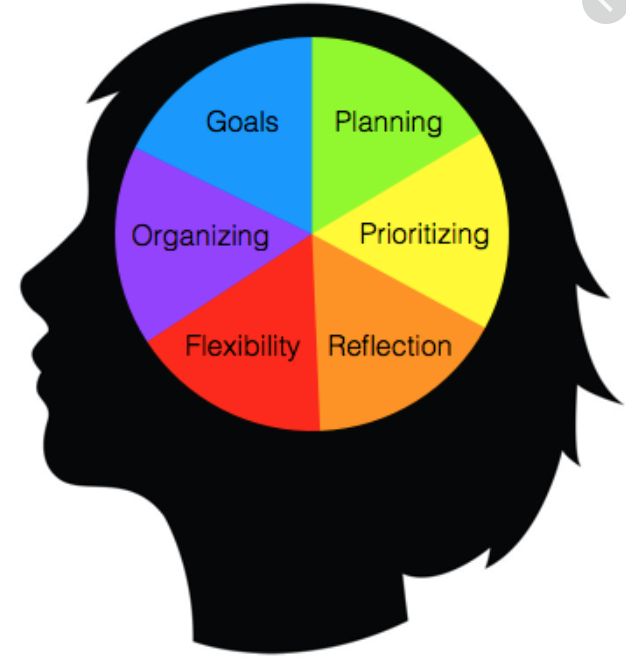
While developing EF skills is crucially important for most 2e learners, it will take time on your part to go into depth to learn and apply the strategies that teach students these skills.
In Brief: To strengthen executive function skills--always start by helping students develop non-verbal working memory.
According to Ward, some strategies to teach students are:
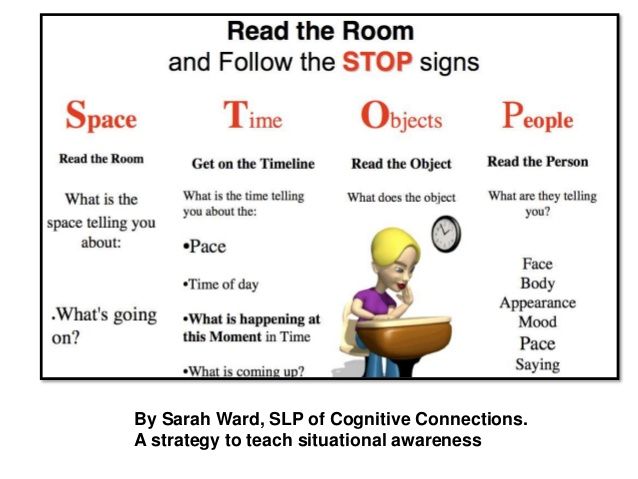
2. Get Ready, Do, Done - Planning Strategy
It is important to start with DONE before GET READY or DO.
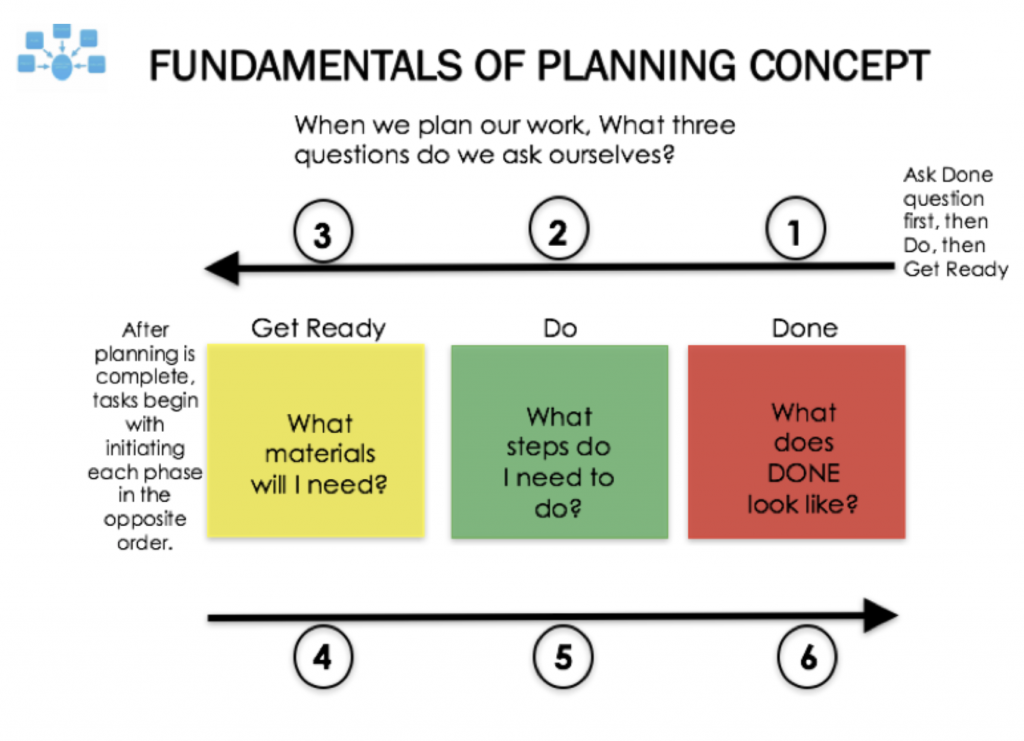
For a 4:03 minute video from one school using Get Ready-Do-Done, see this OPTIONAL video.
3. Time Sweep strategy (Important for students with weak EF to see the passage of time using strategies involving analog clocks.)
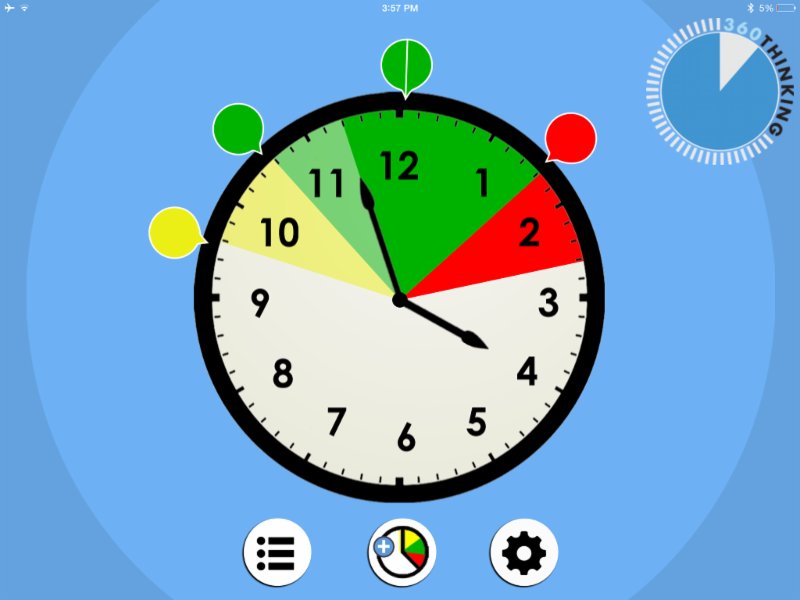
(Sarah Ward-Cognitive Connections)
4. Planners

(Out of the Chaos)
5. Use color with purpose to organize lists & planners.

This is a super brief "balcony view" of the extensive guidance offered by Sarah Ward. If it looks useful, please go deeper into her resources, or check out the many videos on YouTube by her and others (optional).
Optional:
In the Davidson Institute Article -- Tips for Parents: Executive Functioning at Home and School the author points out that, "Weaknesses in EF tend to affect all areas of gifted kids’ lives, including some of what might seem like basic self-care or home life tasks, and can be extremely frustrating for parents and siblings. The article also provides a list compiled from several different sources of executive functions which may be helpful to skim and save for use later
Krista Klabo, CDE's school psychology and special education evaluation specialist has a wealth of resources, including videos of previous presentations on executive functioning. To view these resources, go HERE.
Curriculum Resources (from Krista Klabo's presentation on Strategies and Best Practice: Executive Functioning Assessment, Dec 14, 2021
The Alert Program: How Does Your Engine Run?
BrainWise: 10 Wise Ways to Stop and Think
The Incredible 5-Point Scale
The Incredible Years
In Focus: Improving Social and Emotional Intelligence One Day at a Time
Kindness in the Classroom: Random Acts of Kindness Foundation
MindUp
RULER-Yale Center for Emotional Intelligence
EF in the Classroom
Sarah Ward strategies such as STOP and Read the Room, Job Talk, Working Clock and Get Ready, Do Done.
SecondStep: Skills for Social and Academic Success
Stop & Think Social Skills Program (Project ACHIEVE)
Superflex: A Superhero Social Thinking Curriculum
You are a Social
Detective-Explaining Social Thinking to Kids
The WhyTry Program
Zones of Regulation: A Framework to Foster Self-Regulation & Emotional Control
Kidspiration
Training Opportunities for Teachers and Schools through Unstuck. See PDF and website.
Relationship Skills
Remember, according to Maslow, our psychological needs must be met before we can develop a sense of love and belonging, which requires a sense of trust in others. The higher needs on the pyramid (from the previous chapter) will never be reached if an individual has not developed a sense of belonging and trust in others.
Here are some ideas to help 2e students with the very basic need of belonging:
- Support students who are twice-exceptional by helping them to connect with peers. 2e students compare themselves with their peers, and it important that the 2e students see their potential, and do not sell themselves short.
- Provide a mentorship with an adult who is also gifted, and preferably also has a disability--is 2e. This relationship can lend encouragement and hope to those who are frustrated with their school experiences.
- Ensure parents' understanding of their child's giftedness and disability, emphasizing the child's potential. Build a collaborative relationship with parents to create a school-home partnership that supports the child.
Begin by Increasing Intrapersonal Understanding (within self)
- Teach them coping strategies to use when they become frustrated.
- Teach children to identify and verbalize feelings - maybe through journaling for personal reflection.
- Help children realize that mistakes are part of learning and to recognize their own negative self-talk.
- Help them set realistic short-term and long-term goals. Celebrate when they achieve them.
- Teach them to practice self-evaluation - maybe help them to compare how the teacher grades vs. how they grade themselves.
- Teach them that hard work leads to success and that they control their own destiny.
- Introduce and discuss learning styles and personality styles so that they begin to understand individual differences.
- Encourage them to reflect on outcomes that when well and what went poorly.
- Teach them strategies to solve their problems and manage their behavior.
Next focus on Interpersonal relationships.
- Encourage counseling to monitor student emotions.
- Help them to develop friendships and affiliations with peers.
- Work with them to understand both verbal and nonverbal communication cues and gestures.
- Help them learn how to collaborate.
- Teach them friendship skills.
- Create an open climate in the classroom that accepts diversity and discourages bullying.
- Teach "teacher pleasing" skills such as handing in assignments, bringing supplies and books to class, being on time, not disturbing others.
- Teach them to be self-advocates by knowing themselves - what their needs are and how to get their needs met.
- Providing a structured learning environment that encourages positive social interactions
- Increasing opportunities for positive peer interactions
- Giving twice-exceptional students opportunities to act in leadership roles
- Build a collaborative relationship with parents emphasizing the student’s potential
- Support student’s future goals and career planning
- Provide mentorship options
Credit: Emily King, 2005
Decision-Making
Again, all students need instruction and support in this core social-emotional competency, but gifted and 2e students need specific support.Risk-taking
Gifted and talented students who succeed too easily often develop an aversion to taking risks because they have developed an identity based on easy performance--a fixed mindset. Some students with low self-esteem, which 2e and other disabled students are at high risk for having, also might avoid taking risks or trying hard because they don't believe they can succeed. You already know about the importance of a growth mindset and grit, but it is worth listening to the woman who brought the grit research to us. Watch the following video (6:12 minutes) for your own inspiration and think about how you might implement this concept with your case study student.
(Close captioning should be on, but if you don't see it, choose HERE. If you wish to turn it off, click "cc" in the bottom right of the video.)
Underachievement
Underachievement is generally defined as a discrepancy between a child’s actual ability and their school performance. With this definition, most 2e learners, unless they are getting dual differentiated support are most likely underachieving.
Two common 2e characteristics, having a disability and low self-esteem, are two factors known to cause underachievement. (Other factors include internal factors such as perfectionism, avoidance behaviors, and rebellion and external factors such as low expectations and being in a group subject to bias (race, gender, or sexual orientation.) It is imperative that we determine the reason for why the child is underachieving (root cause) so that we provide the appropriate supports for the student.

Brene Brown (2018) cautions that "If the culture of our school...requires armor because of issues like racism, classism, sexism, or any manifestation of fear-based leadership, we can't expect wholehearted engagement" (14). Some students underachieve in response to inappropriate educational conditions or environments.
Two common 2e characteristics, having a disability and low self-esteem, are two factors known to cause underachievement. (Other factors include internal factors such as perfectionism, avoidance behaviors, and rebellion and external factors such as low expectations and being in a group subject to bias (race, gender, or sexual orientation.) It is imperative that we determine the reason for why the child is underachieving (root cause) so that we provide the appropriate supports for the student.

Brene Brown (2018) cautions that "If the culture of our school...requires armor because of issues like racism, classism, sexism, or any manifestation of fear-based leadership, we can't expect wholehearted engagement" (14). Some students underachieve in response to inappropriate educational conditions or environments.
The Venn Diagram below illustrates multiple causes of underachievement and situates 2e students as one group at risk.
The Venn Diagram below illustrates multiple causes of underachievement and situates 2e students as one group at risk.
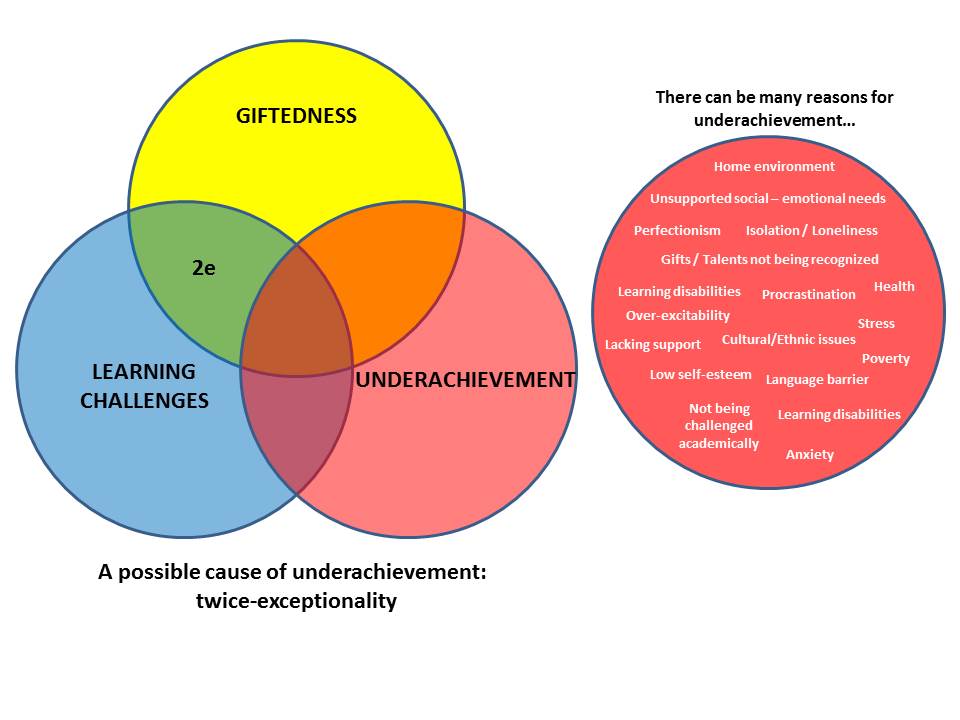
Optional:
From a long-recognized expert on underachievement, Sylvia Rimm, you can read the following article: Bright Kids, Poor Grades: and What you Can Do About It In this article Dr. Rimm offers strategies to support students and families.
Strategies: Big Picture Support 1
Micaela Bracamonte outlines several strategies in describing what twice-exceptional students need. Here are the highlights from the article.
Strategies 1: Playing to their Strengths
Research shows that 2e children are quite capable of high-level abstract thinking, demonstrate significant creativity, and are able to take unique problem-solving approaches to tasks (Trail, 2000). Offering learning opportunities that draw on these abilities is likely to engage these students and give them opportunities for success. At the same time, caution is essential when setting the level of challenge for 2e students. It needs to be appropriate – high enough so that they must stretch to meet the challenge, but not so high that they will fail. Here is where supports in the learning environment come into play. (We will go more into taking a strength-based approach in lesson 3.)
Strategy 2: Addressing Social and Emotional Needs
2e students need a nurturing environment that supports the development of their potential. An encouraging approach is recommended over implementing measures from a punitive perspective (Strop & Goldman, 2002). Teachers provide a nurturing environment when:
- They value individual differences and learning styles.
- Student readiness, interests, and learning profile shape instruction.
- Instruction includes activities for multiple intelligences.
- Flexible grouping is used for instruction.
- The development of student potential is encouraged.
- Students are assessed in accordance with their abilities.
- Excellence is defined by individual growth.
Strategy 3: Incorporating Counseling Support
The drive to achieve perfection, common in many gifted children, generates much psychological conflict in academically talented children who have difficulty achieving (Olenchak, 1994). One survey of gifted students with LDs found them to be emotionally upset and generally unhappy because of their frustrations; in particular, “virtually all had some idea that they could not make their brain, body, or both do what they wanted” (Schiff et al., 1981). Furthermore, 2e students can be very self-critical, which can lead to a particularly dysfunctional form of perfectionism. Counseling is recommended to address their unique needs and should be available on an as-needed basis.
The importance of providing counseling for these students has been noted in many studies from the time 2e children were first identified (Brown-Mizuno, 1990; Hishinuma, 1993; Mendaglio, 1993; Olenchak, 1994; Suter & Wolf, 1987). The benefits of both group and individual counseling have been identified by numerous researchers (Baum, 1994; Mendaglio, 1993; Olenchak, 1994). Group counseling can, for example, help students see that others’ experiences are similar to their own. Learning in a classroom with other 2e students, in itself, can go a long way towards providing this support. The counseling role can sometimes be undertaken by teachers who understand well the needs of 2e students (Baum et al., 1991; Daniels, 1983; Hishinuma, 1993). However, some students may require individual counseling. Parents also need information and, in cases, counseling to help them understand the characteristics and needs of their gifted children with learning challenges (Bricklin, 1983; Brown-Mizuno, 1990; Daniels, 1983).
Strategy 4: Providing Organizational Guidance and One-on-one Tutoring Opportunities
A lack of organizational, time management, and study skills can have a negative impact on both the emotional well-being and school performance of twice-exceptional students. Many in the 2e research community agree that it is critical that students receive explicit instruction and support to develop this battery of skills. These students also need prescriptive, individualized intervention services related to their areas of academic challenge, such as reading, writing, or math. This focus on relative weaknesses should, as much as possible, be woven into projects in areas of student strengths, with accommodations and adaptations in place as long as students need them (and no longer). Long-term, project-based learning affords ample opportunities for teachers to naturalistically scaffold acquisition of these skills in both group learning and one-on-one mentored situations.
Strategy 5: Integrating Technology
Accommodations, particularly the use of assistive technology, are highly recommended to help these academically talented students compensate for their learning challenges (Baum et al., 1991; Howard, 1994; Suter & Wolf, 1987; Torgesen, 1986). Such techniques may be helpful to many LD students, but they are especially beneficial to those who are also gifted and in need of moving ahead in their areas of strength. For example, students who are capable of a high level of mathematical problem solving, but who have difficulty with simple computations, could be given a calculator so that they won’t be held back. A laptop computer loaded with voice-recognition software, word prediction, brainstorming/planning software, and a spell checker can be enormously helpful to a student whose problems lie in writing and/or spelling, but whose ideas are complex and sophisticated. Students who have difficulty taking notes in class can be allowed to record lectures. Recorded books and other information sources not dependent on reading (such as films) might also help students who have reading challenges but strong auditory processing skills.
- - - - - -
To continue reading the article, please click HERE
Strategies: Big Picture Support 2
From Social and Emotional Learning and Intensive Intervention by the National Center on Intensive Intervention at the American Institutes for Research comes the following quick charts for Tier 1 through Tier 3 supports for each of CASEL's 5 core competencies. For the full article go HERE. A PDF version is also in our shared Google folder. (For an accessible copy for the visually impaired, contact Cynthia at rundquist_c@cde.state.co.us)
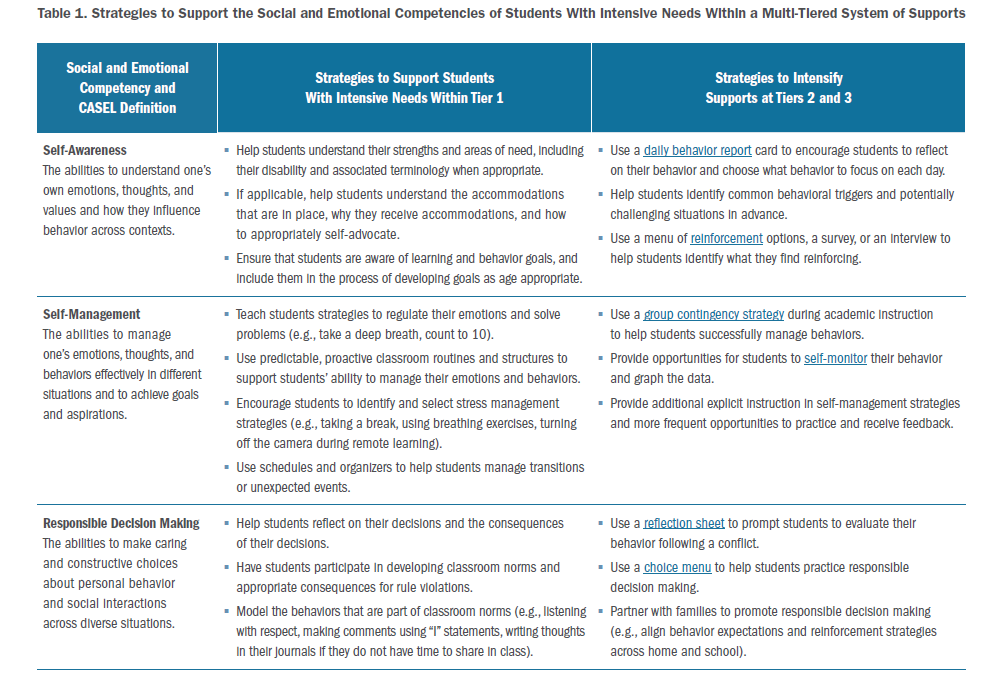
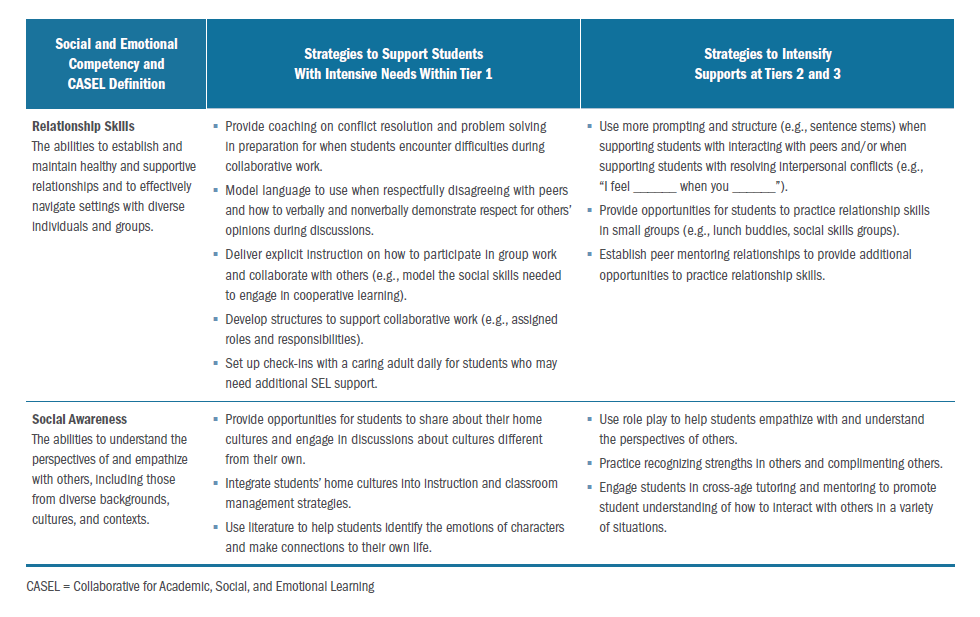
Strategies: Big Picture Ideas, conclusion
As a way to recap all that we have covered in this lesson - here are some ideas to embrace when working to supporting the social and emotional needs of the twice-exceptional child (courtesy of the 2e Newsletter).
1. Foster a clear understanding with the child of his/her disability as well as their strengths.
2. Continually encourage twice-exceptional students to success and enlist the support of their parents and teachers.
3. Teach students to set realistic goals.
4. Teach students coping strategies to use when they become frustrated.
5. If needed, encourage counseling to effectively monitor each student's emotions that accompany frustrations and perceived failures.
6. Remind yourself and encourage others to recognize the unique needs of twice-exceptional students.
7. Provide support in establishing and maintaining social relationships by introducing a structured learning environment that encourages positive social interactions with peers in and out of the classroom.
8. Give students who are twice-exceptional opportunities to act in leadership roles with peers, especially in areas where they excel.
9. Increase the opportunities for peer interactions in the classroom while supporting students in the appropriate use of social skills.
Final Thoughts...
Promote self-understanding and self-acceptance
Teach coping strategies to use when they become frustrated
Encourage counseling to monitor student emotions
Provide support in maintaining social relationships by:
- Providing a structured learning environment that encourages positive social interactions
- Increasing opportunities for positive peer interactions
- Giving twice-exceptional students opportunities to act in leadership roles
Build a collaborative relationship with parents emphasizing the student’s potential
Support student’s future goals and career planning
Provide mentorship options
2 FREE SEL Courses - Optional
For a free 4-hour course on social-emotional learning in general you can go HERE
Creating a Well-Rounded Educational Experience: Introduction to Social and Emotional Learning, a free online course from AIR, was designed as an introduction to social and emotional learning (SEL) for educators who endeavor to create a well-rounded educational experience. This introductory course is designed for all educators—teachers, counselors, principals, support staff, custodians, cafeteria staff, and afterschool providers—to ensure that the whole school community is engaged in the adoption and implementation of sustainable SEL practices.
Optional Resources for Supporting Mental Health of 2e Learners
These are resources you might save for future investigation and consultation.
SEL - School Counsel(l)ors from Across the World
This is a space and a place for School Counsel(l)ors, School Counsel(l)or Educators, School Counselling interns and School Counsel(l)ing students to create and share A global School Counsel(l)or hub and network. Creating community, collaborations and resources. We are better together.
Affective/Social Emotional Resources
- “Gifted Kids at Risk: Who’s Listening?” (Dr. Pat Schuler).
- Indiana Department of Education. Guiding Students with High Abilities: Social/emotional Considerations. 2nd Edition 2010
- “Addressing the Social and Emotional Needs of Twice-Exceptional Students” (Emily Williams King)
- “The Affective Side: Emotional Issues of Twice-Exceptional Students” (Jean Strop and David Goldman)
Overexcitabilities
Perfectionism
- The Many Faces of Perfectionism (Etienne Benson)
- What's Wrong With Perfect? (Sylvia Rimm)
Procrastination
- “The Problem of Procrastination” (T. Quek)
Underachievement
There are many resources out there offering strategies and tips for parents and teachers to help underachieving students to become achievement-oriented individuals. What follows on this page are some resources for you to support you as you work with underachieving students.
- Davidson's Institute founded in 1999 offers much-needed support to profoundly gifted young people through programs and services. They also offer a great database filled with helpful articles. Another great article for reference on underachievement can be found here: Tips for Parents: What You Can do to Reverse Underachievement in the Classroom.
- ACT Government Education and Training. Betts/Niehart (2010) Revised Profiles of Gifted and Talented/Underachievement
- Reis, S. & McCoach, D. (2000) National Association of Gifted Children: Vol. 44, No. 3, pp. 152-170. The underachievement of gifted students: What do we know and where do we go? This article reviews and analyzes three decades of research on the underachievement of gifted students in an attempt to clarify the present state of research.